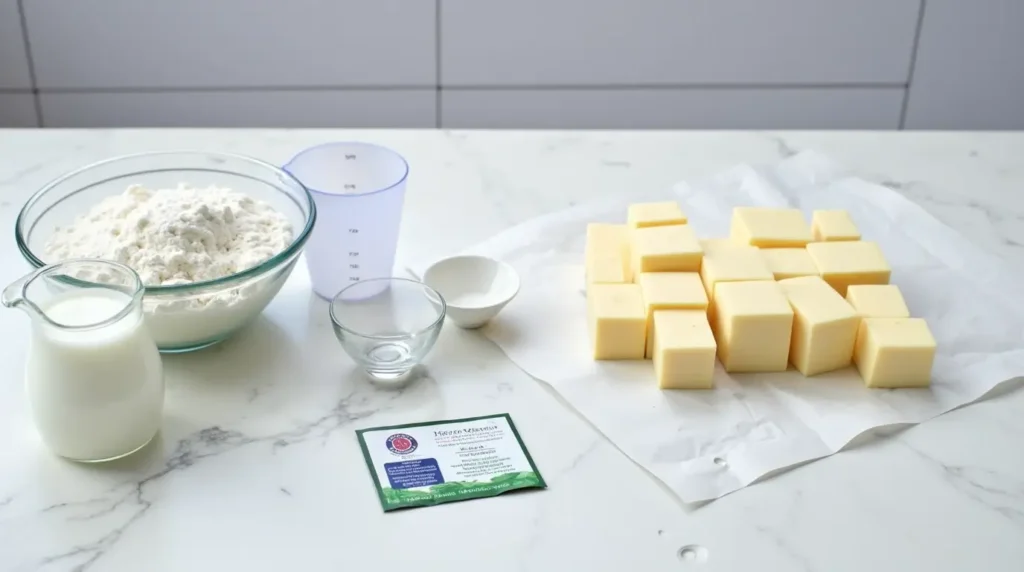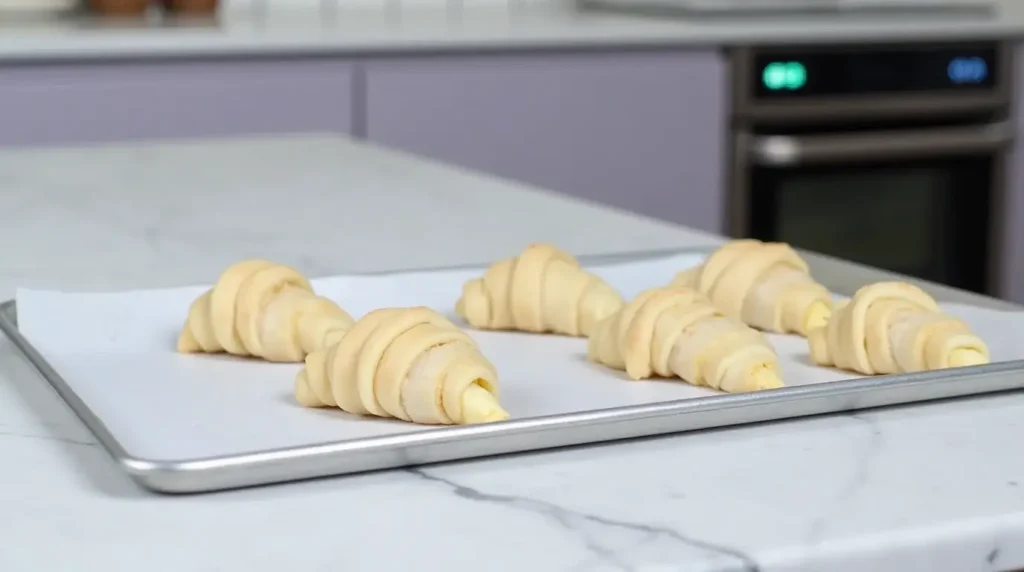
Croissants are more than just a breakfast staple; they’re a symbol of French culture and craftsmanship. In this guide, we’ll take you through every step of creating a flaky, golden, and buttery croissant right in your own kitchen. From selecting the right ingredients to mastering authentic techniques, we’ve got you covered. By the end of this journey, you’ll be armed with all the tips and secrets to baking croissants that rival those from a Parisian bakery.
Let’s dive into the history, ingredients, and essential steps for creating the ultimate French croissant recipe. Bon appétit!
What is a Croissant?
A croissant is a crescent-shaped, flaky pastry known for its layers of buttery goodness. Originally inspired by Austrian kipferl, this pastry was perfected in France, where it became a breakfast icon. Its hallmark is its laminated dough, a technique involving multiple folds of butter and dough to create the signature layers.
Why French Croissants Are Famous
French croissants are celebrated for their delicate texture and rich flavor. What sets them apart is the use of high-quality butter, precise techniques, and attention to detail. In France, croissants aren’t just a snack—they’re a cultural experience. Whether paired with coffee or enjoyed alone, their crispy exterior and tender interior make them irresistible.
The Essential Ingredients for a French Croissant Recipe

Choosing the Right Flour for Croissants
The foundation of every French croissant recipe lies in the flour. French bakers often use T55 flour, which has a slightly lower protein content compared to all-purpose flour. This unique characteristic ensures the dough remains elastic yet firm enough to hold its delicate layers. For home bakers, unbleached all-purpose flour with moderate protein content can serve as a suitable alternative. Using the right flour is crucial for achieving that flaky, airy texture that defines an authentic croissant.
The Role of Butter in Croissants
Butter isn’t just an ingredient; it’s the soul of a croissant. High-quality, European-style butter with a higher fat content (at least 82%) is ideal. This type of butter ensures smooth lamination and contributes to the croissant’s rich flavor and golden color. Cold butter is essential during the folding process to maintain distinct layers, so don’t skimp on chilling time.
Other Key Ingredients: Yeast, Sugar, and Salt
Active dry yeast or instant yeast works perfectly for the fermentation process. Yeast helps the dough rise, creating the light and airy structure that croissants are known for. Sugar adds a hint of sweetness, balancing the butter’s richness, while salt enhances the overall flavor profile. These basic yet vital components come together to create the perfect dough.
For those interested in exploring ingredient details further, this recipe offers insights into working with staple ingredients for diverse recipes.
Step-by-Step French Croissant Recipe
Preparing the Dough: Mixing and Kneading
Start by combining your dry ingredients—flour, yeast, sugar, and salt—in a large bowl. Gradually add cold milk while mixing, ensuring a smooth consistency. Knead the dough until it’s soft and pliable. Refrigerate it for at least 6 hours (or overnight) to allow the gluten to relax.
Rolling and Folding: Creating the Layers
Lamination is the art of layering butter and dough. Roll out the dough into a rectangle and encase a chilled slab of butter in its center. Fold the dough over the butter like a letter, ensuring the edges are sealed. Roll it out gently and fold again, repeating the process three times. Each fold creates multiple thin layers of dough and butter.
Shaping the Croissants
Once the laminated dough is ready, roll it into a large sheet. Cut triangles of dough and roll them tightly from the base to the tip to form the classic crescent shape. Ensure the tip is tucked underneath to prevent it from unrolling during baking.
The Proofing Process
Place the shaped croissants on a baking tray lined with parchment paper and let them proof in a warm, draft-free spot. The dough should double in size, which can take 1–2 hours depending on room temperature. Proofing is critical for achieving a light and airy texture.
Baking: Achieving the Perfect Golden Layers
Preheat your oven to 375°F (190°C). Brush the croissants with an egg wash to enhance their golden sheen. Bake for 15–20 minutes, or until the layers puff up beautifully and the tops are golden brown. Let them cool slightly before indulging.
For more on mastering recipes that require similar precision, check this guide on moist bread techniques.

Tips for Perfecting Your French Croissants
How to Achieve a Flaky Texture
Creating the perfect layers in a French croissant recipe requires a balance between technique and patience. First, keep your butter cold throughout the lamination process. Warm butter can melt into the dough, ruining the distinct layers. If your dough becomes sticky while rolling, pop it back into the fridge for a quick chill. Additionally, roll the dough evenly to maintain consistent thickness—this ensures the croissants bake evenly, resulting in a crispy exterior and a soft, airy interior.
Troubleshooting Common Issues
Sometimes, croissants may not turn out as expected. If your croissants lack puffiness, the yeast may not have been activated properly, or the dough might not have proofed long enough. On the other hand, if they spread instead of rising, the butter might have melted prematurely during lamination. Always work in a cool environment and avoid over-handling the dough. Remember, practice makes perfect!
The Importance of Temperature and Timing
Temperature control is crucial for baking success. Let the croissants proof at a consistent, warm temperature (around 75°F or 24°C). Too cold, and the dough won’t rise properly; too warm, and the butter may melt. Baking at 375°F (190°C) ensures a beautifully golden crust without overcooking the delicate layers inside.
For those experimenting with similar flaky pastries, check out this guide on breakfast casseroles. It’s a great way to expand your breakfast repertoire!
The Secret to a Truly Authentic French Croissant
Understanding the French Techniques
The French approach to making croissants is rooted in precision and tradition. Authentic croissant recipes rely on using ingredients like T55 flour and high-fat butter, but the real secret lies in the folding technique. The classic “book fold” and “single fold” create the iconic layers that define a croissant. Every fold adds new dimensions of flakiness, so perfecting this technique is key.
French bakers also focus heavily on timing. Dough fermentation is never rushed; it’s allowed to develop flavor slowly. By giving the dough enough time to rest and proof, the final croissants carry that rich, nuanced taste and texture.
Cultural Significance of the Croissant in France
In France, the croissant is more than a breakfast staple—it’s a symbol of culinary art. From small boulangeries to high-end patisseries, croissants hold a revered spot in French culture. Their versatility is another reason for their popularity; whether paired with jam, butter, or served plain, croissants are enjoyed by people of all ages.
For more culinary inspiration, you might enjoy this recipe for avocado toast with egg, which complements the buttery goodness of croissants with a savory twist.
What Do the French Serve with Croissants?
Popular French Croissant Pairings
When it comes to enjoying a French croissant recipe, simplicity is key. The French often serve croissants with a generous dollop of butter or fruit preserves like apricot, raspberry, or strawberry. The mild sweetness of jam complements the rich, buttery layers of the croissant, making it a delightful breakfast treat. For those seeking a savory option, soft cheeses such as brie or fresh chèvre pair wonderfully with croissants.
Serving Suggestions for Breakfast or Snack
Croissants shine as part of a balanced French breakfast. A classic pairing includes a steaming cup of coffee or café au lait, with croissants served warm from the oven. For a heartier meal, try combining croissants with a fresh fruit platter or a side of eggs for added protein. Croissants also make for an elegant snack at any time of day, offering a light and satisfying option when paired with herbal tea or a sparkling water.
To explore more breakfast ideas that complement croissants, consider reading this guide on spinach mushroom quiche.
Nutritional Content of French Croissants (Per 100g)
Understanding the nutritional profile of croissants can help you enjoy them as part of a balanced diet. Below is the approximate nutritional content of a classic French croissant recipe per 100 grams.
| Nutrient | Amount (per 100g) |
|---|---|
| Calories | 406 kcal |
| Total Fat | 21 g |
| Saturated Fat | 12 g |
| Cholesterol | 49 mg |
| Sodium | 370 mg |
| Total Carbohydrates | 45 g |
| Dietary Fiber | 2 g |
| Sugars | 8 g |
| Protein | 8 g |
| Calcium | 32 mg |
| Iron | 2.1 mg |
Key Nutritional Highlights
- Calories: French croissants are calorie-dense due to the butter and flour content, making them an indulgent treat.
- Fats: The high-fat content is primarily from butter, contributing to their flaky texture.
- Carbohydrates: Croissants provide a quick source of energy, with moderate fiber content.
- Protein: The protein comes mainly from the flour and butter used in the dough.
Enjoy croissants as part of a balanced diet, pairing them with fresh fruits or protein-rich accompaniments for a wholesome meal!
FAQs on French Croissants
What Makes French Croissants Different?
French croissants stand out because of their unique lamination process, which creates multiple layers of dough and butter. This technique results in the signature flaky texture and rich taste that make croissants irresistible. Additionally, French bakers often use specialty ingredients, such as T55 flour and high-fat European butter, which elevate the quality of the final product.
What Flour Do French Use for Croissants?
The most common flour used in France for croissants is T55 flour. It has a balanced protein content, providing enough strength for gluten development while remaining soft enough to yield a tender crumb. If T55 flour isn’t available, unbleached all-purpose flour with moderate protein content works well for a homemade French croissant recipe.
What Is the Secret to a Good Croissant?
The secret lies in two factors: patience and precision. From properly chilling the dough to ensuring even folds during lamination, each step is crucial. Proofing the croissants in a warm but not overly hot environment ensures they rise without melting the butter, while baking at the right temperature guarantees a golden, flaky exterior.
What Do the French Put on Croissants?
French people often enjoy their croissants plain or with simple toppings like butter and jam. Honey, chocolate spreads, or a sprinkle of powdered sugar are other popular choices. For a savory twist, adding a slice of cheese or smoked salmon can transform the humble croissant into a gourmet delight.
With these tips and pairings, you’ll be able to enjoy croissants the French way, whether as part of a leisurely breakfast or a quick snack.
Variations and Alternatives to the Classic French Croissant Recipe
Butter-Free Croissants for Special Diets
For those following a dairy-free or vegan lifestyle, it’s still possible to enjoy a croissant-inspired treat. Replace the butter in the French croissant recipe with plant-based margarine or vegan butter with a high fat content. While the layers may not be as rich as traditional croissants, this variation offers a satisfying alternative without compromising too much on texture.
Sweet Croissant Variations: Chocolate and Almond
Sweet croissants are a beloved twist on the classic. Pain au chocolat, or chocolate croissants, are made by placing dark chocolate bars inside the dough before rolling. For almond croissants, a mixture of almond paste, sugar, and butter is spread inside the croissant and over its surface before baking. These variations add an indulgent sweetness, perfect for dessert or an afternoon treat.
Savory Croissants: Cheese and Herbs
Savory versions of the French croissant recipe are equally delightful. Sprinkle shredded cheese like gruyere or cheddar between the layers during lamination for a cheesy flavor in every bite. Herbs such as rosemary or thyme can be mixed into the dough for an aromatic twist, turning these croissants into a perfect side for soups or salads.
If you’re experimenting with flavors, you might find this guide on Mediterranean recipes inspiring for additional pairing ideas.
Conclusion and Final Thoughts
Final Tips for Success
Making croissants from scratch may seem daunting, but with practice and patience, it’s an incredibly rewarding experience. Remember to take your time with each step of the process, from mixing the dough to folding the butter layers. Keeping your workspace cool and your ingredients chilled is essential for success. Whether you’re trying a classic French croissant recipe or experimenting with creative variations, attention to detail makes all the difference.
Why Making Your Own Croissants is Worth the Effort
Baking croissants at home allows you to experience the magic of creating this iconic pastry from start to finish. The buttery aroma filling your kitchen and the joy of biting into a fresh, flaky croissant you made yourself are truly unmatched. Plus, you can customize flavors and sizes to suit your preferences, making every batch unique.
For more baking inspiration, explore this guide on crafting moist bread.
By following this guide, you’ll master the art of croissants in no time. Whether you enjoy them plain, filled, or paired with your favorite accompaniments, these timeless pastries are sure to delight every time!
